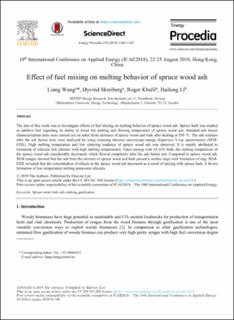| dc.contributor.author | Wang, Liang | |
| dc.contributor.author | Skreiberg, Øyvind | |
| dc.contributor.author | Khalil, Roger Antoine | |
| dc.contributor.author | Li, Hailong | |
| dc.date.accessioned | 2020-05-29T09:09:05Z | |
| dc.date.available | 2020-05-29T09:09:05Z | |
| dc.date.created | 2018-08-24T11:40:36Z | |
| dc.date.issued | 2019 | |
| dc.identifier.citation | Energy Procedia. 2019, 158 1342-1347. | en_US |
| dc.identifier.issn | 1876-6102 | |
| dc.identifier.uri | https://hdl.handle.net/11250/2655986 | |
| dc.description.abstract | The aim of this work was to investigate effects of fuel mixing on melting behavior of spruce wood ash. Spruce bark was studied as additive fuel regarding its ability to lower the melting and flowing temperature of spruce wood ash. Standard ash fusion characterization tests were carried out on ashes from mixtures of spruce wood and bark after heating at 550 °C. The ash residues after the ash fusion tests were analyzed by using scanning electron microscopy-energy dispersive X-ray spectrometry (SEM-EDX). High melting temperature and low sintering tendency of spruce wood ash was observed. It is mainly attributed to formation of calcium rich silicates with high melting temperatures. Upon mixing with 10 wt% bark, the melting temperature of the spruce wood ash considerably decreased, which flowed completely after the ash fusion test. Compared to spruce wood ash, SEM images showed that the ash from the mixture of spruce wood and bark passed a molten stage with formation of slag. SEM-EDX revealed that the concentration of silicon in the spruce wood ash increased as a result of mixing with spruce bark. It favors formation of low temperature melting potassium silicates. | en_US |
| dc.language.iso | eng | en_US |
| dc.rights | Attribution-NonCommercial-NoDerivatives 4.0 Internasjonal | * |
| dc.rights.uri | http://creativecommons.org/licenses/by-nc-nd/4.0/deed.no | * |
| dc.subject | Spruce wood | en_US |
| dc.subject | bark | en_US |
| dc.subject | ash | en_US |
| dc.subject | melting | en_US |
| dc.subject | gasification | en_US |
| dc.title | Effect of fuel mixing on melting behavior of spruce wood ash | en_US |
| dc.type | Journal article | en_US |
| dc.description.version | publishedVersion | en_US |
| dc.rights.holder | The Authors | en_US |
| dc.source.pagenumber | 1342-1347 | en_US |
| dc.source.volume | 158 | en_US |
| dc.source.journal | Energy Procedia | en_US |
| dc.identifier.doi | 10.1016/j.egypro.2019.01.329 | |
| dc.identifier.cristin | 1604273 | |
| dc.relation.project | Norges forskningsråd: 244069 | en_US |
| cristin.unitcode | 7548,70,0,0 | |
| cristin.unitname | Termisk energi | |
| cristin.ispublished | true | |
| cristin.fulltext | original | |
| cristin.qualitycode | 0 | |

